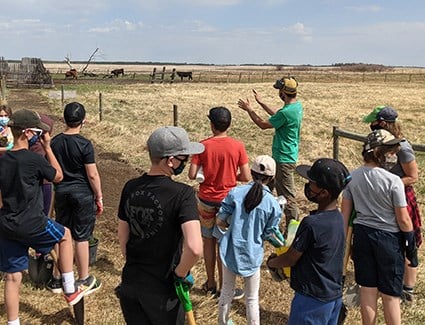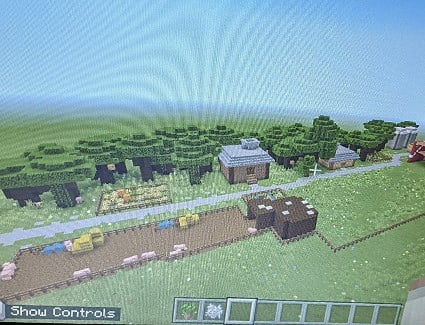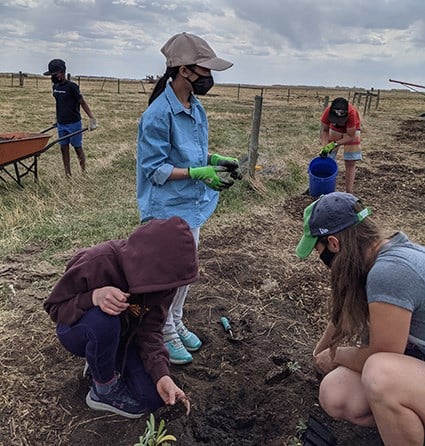 Students at École Victoria are growing their relationship with the natural world as they grow as learners.
Students at École Victoria are growing their relationship with the natural world as they grow as learners.
From planting hundreds of native plant seeds to plotting a design using Minecraft, the Grade 6 and 7 students in teacher Ben Oaken's classroom are creating an eco buffer on previously cultivated land through a partnership with Grovenland Farm, located east of Saskatoon. The project was facilitated through the One School One Farm Shelterbelt Project.
"The goal of this project is to establish areas of native trees, shrubs, grasses, and flowers that can benefit the soil health and wellbeing of previously cultivated areas," Oaken explained. "It is an amazing fit for our learning because we are exploring biodiversity and with it the science of climate change. It is extremely important to me that my students understand that not all human interaction with the environment must be negative or destructive."
The eco buffer project for Grovenland Farm will establish an area of biodiverse native plant, shrub, grass, and tree species that have a positive impact on soil health and act as a food source for wildlife.
Students developed a database of species that fit into their design now and for the future. They learned how each plant has a specific role in a collective, healthy ecosystem and gained knowledge on everything from which species promote soil health to those that offer wind protection. Hundreds of seeds originally harvested by other students at the Brightwater Science, Environmental and Indigenous Learning Centre were planted in the classroom.
 "To keep it fun and age appropriate, we recreated the layout of the project using the game Minecraft and made 3D models of the farm and the buffer. From that learning, we selected species we thought would best suit the region and that were readily available, then made a final planting map of our eco buffer," Oaken said.
"To keep it fun and age appropriate, we recreated the layout of the project using the game Minecraft and made 3D models of the farm and the buffer. From that learning, we selected species we thought would best suit the region and that were readily available, then made a final planting map of our eco buffer," Oaken said.
The response of students and the opportunity for active, hand-on learning has been positive. When they travelled to the farm in mid-May to plant more than 200 trees, Oaken said the passion for the project was obvious.
"On planting day, I was blown away with the dialogue between students and saw they deeply understand the gifts and characteristics the plants provide. Their conversations about why certain species should go where and their ability to use teamwork and delegate tasks was a very special moment for me."
As part of the project Lisa and Ben Martens Bartel, the operators of Grovenland Farm, connected with the students to demonstrate the ways their farming practices benefits biodiversity and soil health, and provides food in a way that doesn't negatively impact the environment in the same way as other types of agriculture may.
The integrated learning involved in the project allows students to meet curricular outcomes in multiple subjects including science, math, and social studies. Oaken said the experience helps students understand they are part of nature and not above it.
 "They see first-hand that the plants they are learning from are living, breathing organisms with unique roles and services necessary for the success of a healthy ecosystem," he said. "Then, they better understand that our role and relationship to the natural world requires restorative positive action. This knowledge empowers them with the tools needed to help combat the effects of climate change that will, no doubt, affect them in their lifetime."
"They see first-hand that the plants they are learning from are living, breathing organisms with unique roles and services necessary for the success of a healthy ecosystem," he said. "Then, they better understand that our role and relationship to the natural world requires restorative positive action. This knowledge empowers them with the tools needed to help combat the effects of climate change that will, no doubt, affect them in their lifetime."
The goal for the classroom-farm connection developed through the One School One Farm project is to create long-lasting relationships. Oaken said the partnership with Grovenland Farm will continue for several more years.
"Next year, we will be adding several species of native shrubs, flowers, and grasses to our eco buffers to add biodiversity to the areas planting as well as planning and establishing new eco buffer areas. Following that we will be doing routine maintenance and follow up visits to ensure the health and success of our newly established native prairie habitat."